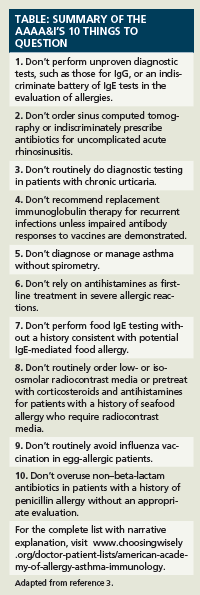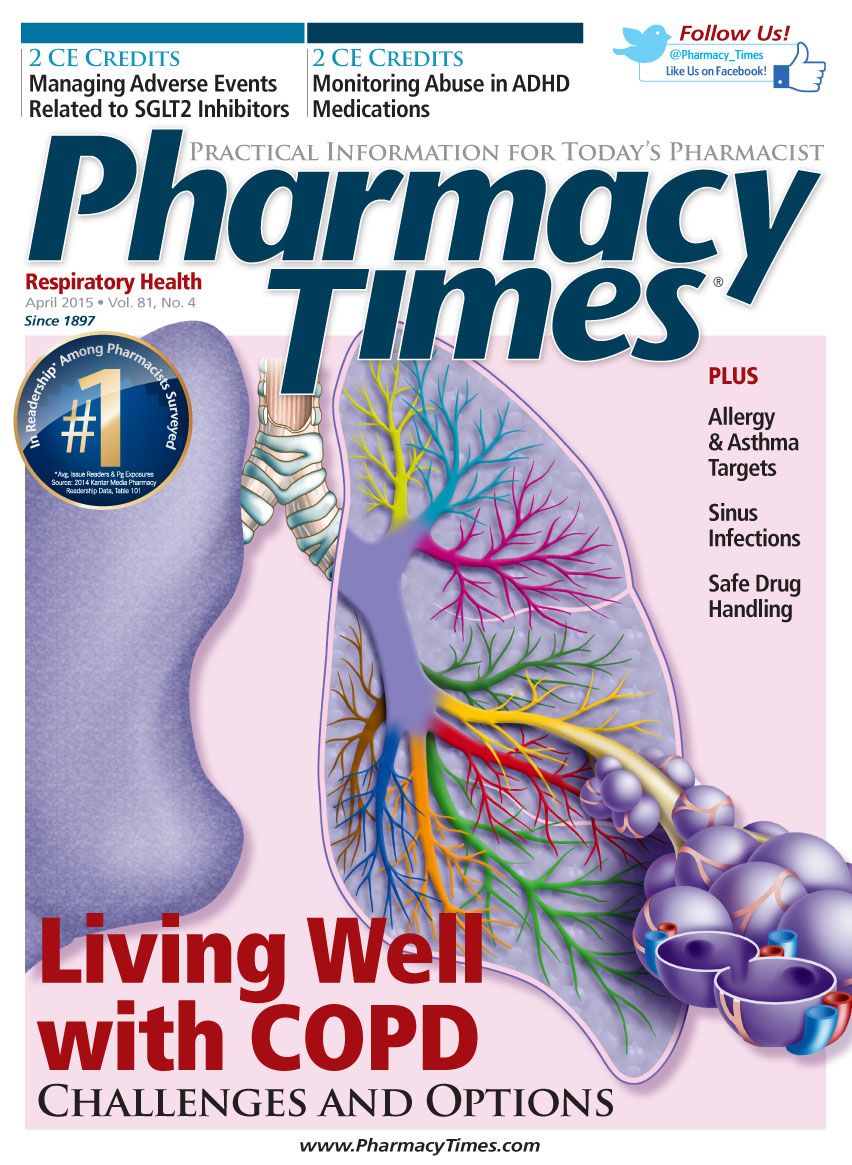Publication
Article
Pharmacy Times
Choosing Wisely: Looking at Allergy and Asthma Targets
Author(s):
Efforts are being made to ensure that health care providers deliver the right care at the right time.
Efforts are being made to ensure that health care providers deliver the right care at the right time.
May I use the topics of allergy and asthma to introduce you to a remarkable tool? Choosing Wisely (www.choosingwisely.org) is an innovative program designed to ensure that health care providers deliver the right care at the right time by encouraging providers to discuss tests and procedures with patients.1,2 In response to this challenge, national organizations have produced lists of “Things Providers and Patients Should Question.” The American Academy of Allergy, Asthma & Immunology’s (AAAA&I’s) list of “10 Things Physicians and Patients Should Question” (Table) includes 6 items that are germane to pharmacists—and discussed below.3
Uncomplicated Rhinosinusitis
Fewer than 2% of cases, however, progress to bacterial infections, so most patients recover within 2 weeks without treatment and do not need a sinus computed tomography scan or other imaging. As pharmacists know, antibiotics are unnecessary for patients with uncomplicated acute rhinosinusitis and mild illness. Nonetheless, if clinicians determine treatment is needed because of comorbidities or complications, amoxicillin should be the first-line antibiotic treatment for most cases of acute rhinosinusitis.3
Immunoglobulin Therapy
Routinely measuring IgG subclasses is not helpful in determining the need for immunoglobulin therapy. Costly immunoglobulin (gammaglobulin) replacement only improves outcomes in patients who have impaired antigen-specific IgG antibody responses to vaccine immunizations or natural infections. Patients who do not require immunoglobulin replacement therapy include those with an IgA deficiency alone, as well as those with low immunoglobulin levels and normal antigen-specific IgG antibody responses. AAAA&I notes 2 exceptions: patients with IgG levels <150 mg/dL and genetically defined/suspected disorders should be treated.3

AAAA&I reports antihistamines are overused as first-line treatment for anaphylaxis. Anaphylaxis has cardiovascular and respiratory components, which mandate epinephrine. Antihistamines have no role in anaphylactic manifestations, and can delay crucial, effective epinephrine. Delaying epinephrine has resulted in fatalities.3 Clinicians—and patients—should administer epinephrine as soon as anaphylaxis is suspected. Antihistamines are appropriate supportive therapy for hives or itching.3
Seafood Allergy & Contrast Media
Approximately 3.5% of Americans indicate they have a seafood allergy. Labeling these patients as being at greater risk for adverse events (AEs) from contrast infusions compromises care since these patients may not receive needed procedures or may have AEs from pretreatment with antihistamines and/or corticosteroids.3
Although the exact mechanism for contrast media reactions is unknown, they are most likely due to the media’s physiochemical properties, not its iodine content. In fact, researchers have been unable to find a cause-and-effect link between iodinated contrast media and seafood allergies. Because there is no elevated risk for seafood-allergic patients, using more expensive agents or premedicating before contrast media in patients with a seafood allergy is unnecessary.
Patients with histories of actual anaphylaxis after taking contrast media should receive low- or iso-osmolar agents and pretreatment with corticosteroids and antihistamines. Clinicians should not tell patients who have had anaphylaxis from contrast media that they are allergic to seafood.3 Pharmacists should note the following patient populations at elevated risk for serious anaphylaxis from radiographic contrast media: patients with asthma or cardiovascular disease or who are taking beta-blockers.3
Egg Allergy & Immunization
Here are some suggested guidelines:
- AAAA&I indicates that immunizers need not take special precautions with egg-allergic patients for measles, mumps, and rabies vaccines, which have just trace amounts of egg protein.
- AAAA&I advises immunizers to administer the egg-free influenza vaccine to egg-allergic patients or to give an egg-based influenza vaccine and observe for 30 minutes after immunization. AAAA&I reviewed 27 published studies enrolling 4172 egg-allergic patients receiving egg-based inactivated influenza vaccine, and found no reactions, however. The studies included 513 people with a severe egg allergy who uneventfully received 597 doses.
- Immunizers should order skin testing with the yellow fever vaccine, administer the vaccine if the skin test is negative, and observe for 30 minutes after immunization. A positive skin test result doesn’t preclude immunization; the vaccine may be given in graded doses with medical observation.3
- Two new inactivated egg-free influenza vaccines (IIV) have been approved for patients 18 years and older: (1) Flucelvax: prepared from the virus propagated in cell culture, and (2) Flublok: recombinant hemagglutinin proteins produced in an insect cell line. For egg-allergic patients 18 years and older, either egg-based IIV can be used with the precautions above or egg-free IIV can be used.3
Penicillin Allergy
Roughly 10% of Americans report a penicillin allergy, but, in actuality, 90% or more of these patients are not allergic and can take penicillin safely. The penicillin allergy is often misdiagnosed; it also diminishes over time in most individuals. For patients labeled penicillin- allergic, there is a high probability of receiving costly alternative antibiotics (eg, vancomycin, quinolones), their medical costs are higher and hospital stays longer, and complications (such as infections with vancomycin-resistant enterococcus and Clostridium difficile) more likely.3
Appropriate diagnosis using skin testing requires evaluation for IgE specific to penicillin. Identifying the overwhelming majority of individuals who can safely receive penicillin and penicillin-like drugs can improve care outcomes and cost containment.3
Endnote
More than 60 specialty organizations have created lists of “Things Providers and Patients Should Question.”1 The lists are an easy way for pharmacists to find current practices in a large number of specialties. They also dispel myths.
Ms. Wick is a visiting professor at the University of Connecticut School of Pharmacy.
References
- Choosing Wisely initiative. Choosing Wisely website. www.choosingwisely.org. Accessed February 2, 2015.
- Choosing Wisely: Consumer Reports is working with doctors to help patients avoid unnecessary and potentially harmful medical care. December 2014. .Consumer Reports website. www.consumerreports.org/cro/health/doctors-and-hospitals/choosing-wisely/index.htm. Accessed February 2, 2015.
- American Academy of Allergy, Asthma & Immunology: 10 things physicians and patients hould Question. March 3, 2014. Choosing Wisely website. www.choosingwisely.org/doctor-patient-lists/american-academy-of-allergy-asthma-immunology. Accessed February 2, 2015.

Newsletter
Stay informed on drug updates, treatment guidelines, and pharmacy practice trends—subscribe to Pharmacy Times for weekly clinical insights.






